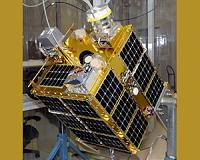 |
Inuvik, Canada (SPX) Aug 12, 2010 On 10 August 2010, the German Aerospace Center inaugurated its first satellite data receiving station in Inuvik, Canada. DLR will use the new ground station particularly to receive data for the German TanDEM-X satellite mission. Using the large, 13-metre antenna, partner countries Germany and Canada as well as scientists from around the world and other external users will be able to access important satellite data, process and evaluate them. The development of new technologies for Earth observation is an important joint objective. Cooperation between DLR, the Canadian Space Agency (CSA) and the Canada Centre for Remote Sensing (CCRS) has existed for many years and will be taken a step further with this new receiving station. "The commissioning of the first DLR ground station in Canada opens a new chapter in German-Canadian cooperation in space. For the first time, facilities of both countries will use their competencies together to receive Earth observation data at a joint location," said Prof. Johann-Dietrich Worner, Chairman of the DLR Board.
Reliable and close to the pole This is an important condition for TanDEM-X to carry out 3D observations of Earth's surface - the mission was launched on 21 June 2010. During this mission, a data volume of up to 350 gigabytes will be read from the onboard memory of the high-resolution radar satellites TerraSAR-X and TanDEM-X, daily, and transferred to the ground. This enormous amount of data requires multiple line-of-sight contacts with a connection time of over two and a half hours per day. DLR has operated a near-polar receiving station at the O'Higgins base on the Antarctic Peninsula for several years, and has pioneered the construction and operation of ground stations in the Antarctic. In addition, DLR also has receiving facilities available at Kiruna in northern Sweden, with its partner, the Swedish Space Corporation. The new Canadian facility completes DLR's global network of receiving stations that are operated by DLR's German Remote Sensing Data Center (Deutsches Fernerkundungsdatenzentrum; DFD) in Oberpfaffenhofen. The starting signal for the commissioning of the new DLR ground station was given in February 2010. DLR signed a bilateral Cooperation Agreement with CCRS for receiving satellite data in Canada. CCRS makes land available in the context of this contract. The commercial partner, PrioraNet Canada (PNC) - a joint venture between the Canadian company Iunctus Geomatics and the Swedish Space Corporation - is responsible for the maintenance and development of the site. As a next step, PNC will build another, identical base station on the site in Inuvik, to mainly serve the Earth observation missions of the French space agency, CNES. A Canadian Government meteorological station is already located at the site. DLR plans to extend this successful cooperation in the future and to create a ground station centre in Inuvik with international cooperation.
Share This Article With Planet Earth
Related Links German Aerospace Center (DLR) Space Technology News - Applications and Research
 NASA's FASTSAT Satellite Arrives At Kodiak
NASA's FASTSAT Satellite Arrives At KodiakHuntsville AL (SPX) Aug 12, 2010 NASA's first microsatellite designed to create a capability that increases opportunities for secondary, scientific and technology payloads, or rideshares, to be flown at lower cost than before has arrived at Kodiak Island, Alaska, to begin final launch preparations. The Fast, Affordable, Science and Technology Satellite, or FASTSAT, arrived at the Kodiak Launch Complex on Aug. 10 from NASA ... read more |
|
| The content herein, unless otherwise known to be public domain, are Copyright 1995-2010 - SpaceDaily. AFP and UPI Wire Stories are copyright Agence France-Presse and United Press International. ESA Portal Reports are copyright European Space Agency. All NASA sourced material is public domain. Additional copyrights may apply in whole or part to other bona fide parties. Advertising does not imply endorsement,agreement or approval of any opinions, statements or information provided by SpaceDaily on any Web page published or hosted by SpaceDaily. Privacy Statement |